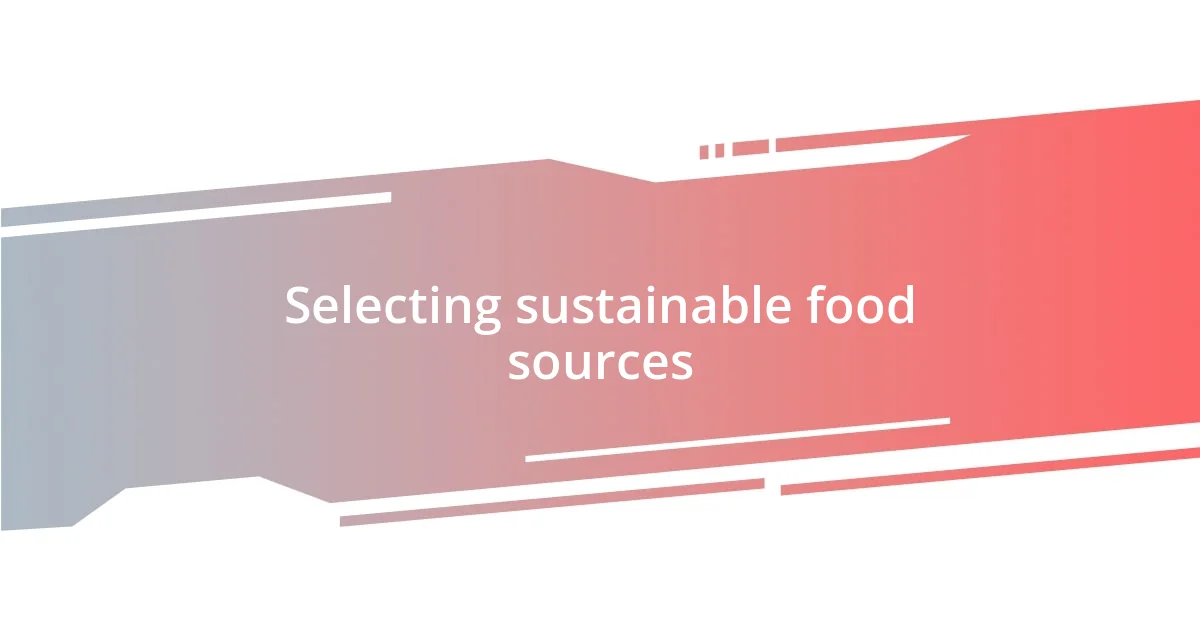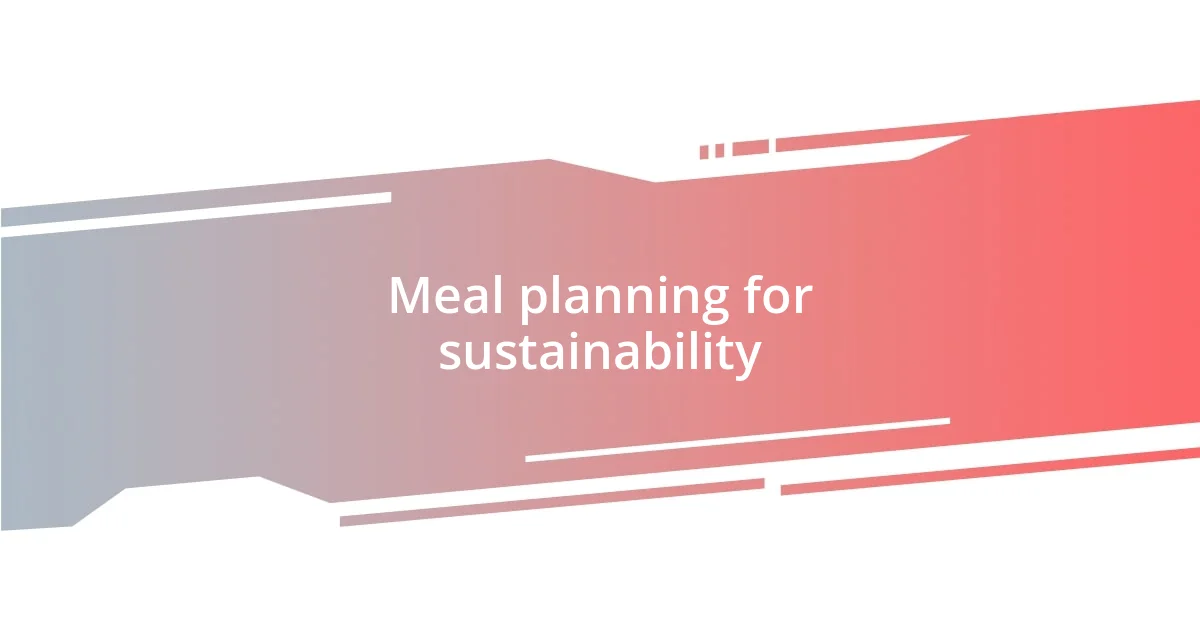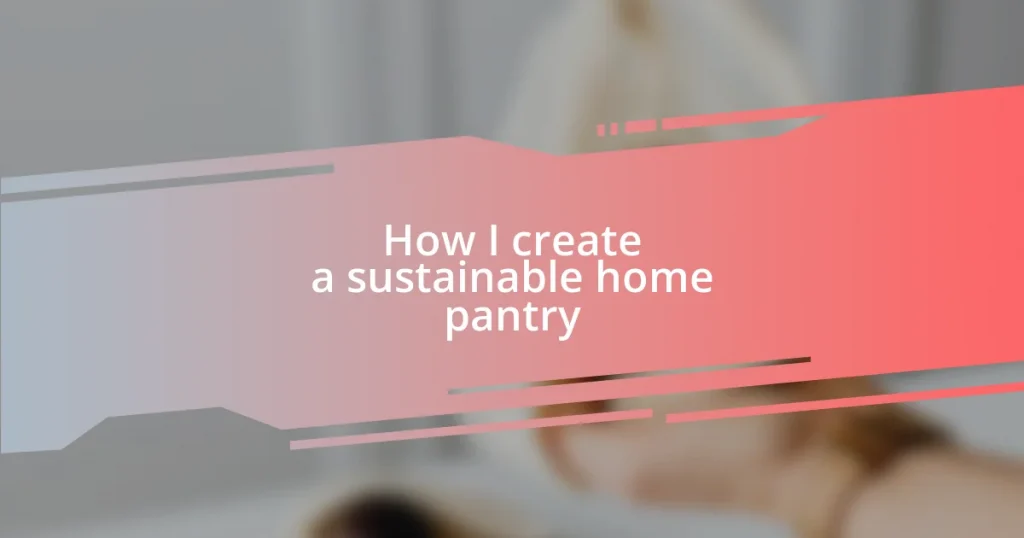Key takeaways:
- A sustainable pantry reflects personal values by prioritizing local, organic ingredients, minimizing waste, and promoting health.
- Effective storage solutions, such as glass jars and repurposed containers, enhance accessibility and sustainability, creating a more organized cooking space.
- Meal planning and seasonal purchasing not only reduce food waste but also foster family engagement and connection to local food systems.

Understanding a sustainable pantry
A sustainable pantry goes beyond just storing food; it embodies a way of living that minimizes waste and promotes health. When I revamped my pantry, I realized that every choice I made was a reflection of my values. Understanding this helped me appreciate not just the items on the shelves, but what they represented—the intention behind purchasing local, organic ingredients.
Every time I open my pantry door, I feel a sense of pride knowing I’m not just stockpiling staples, but curating a collection of nourishing, eco-friendly options. Have you ever thought about how the foods you choose impact your well-being and the environment? It’s a powerful realization that drives me to pick products with minimal packaging or bulk items that reduce my carbon footprint, all while supporting local farmers.
Sourcing sustainable ingredients also made me more aware of seasonal availability and food preservation techniques, like canning and fermenting. I remember my first experience making homemade pickles—what a joy that was! The depth of flavors and satisfaction of creating from scratch taught me to savor not just the food itself, but the process of building a life centered around sustainability. Each item in my pantry now tells a story, reminding me why I started this journey in the first place.

Choosing the right storage solutions
When I started organizing my pantry, I quickly discovered that the storage solutions I chose significantly impacted both accessibility and sustainability. I opted for glass jars rather than plastic containers; not only do they help me see exactly what I have at a glance, but they also avoid the leaching chemicals common in plastics. Each time I refill a jar, I feel a sense of satisfaction knowing that I’m reducing waste while adding a touch of charm to my kitchen.
Here are some effective storage solutions I’ve found useful:
- Glass jars: Perfect for grains, legumes, and snacks; they’re durable and visually appealing.
- Bamboo or metal canisters: Great for dry goods like flour and sugar; they provide an eco-friendly alternative to plastic.
- Cloth bags: Ideal for bulk purchases; I love using these for grains and nuts.
- Repurposed containers: I often reuse old jars or tins for herbs and spices, giving them a second life.
- Magnetic strips: These can be a fun way to store small jars of spices or herbs on the wall, saving counter space and looking aesthetically pleasing.
Choosing the right storage doesn’t just keep things tidy; it reflects my commitment to sustainability and enhances my cooking experience. It’s amazing how a few thoughtful choices can turn a pantry into a true home hub.

Selecting sustainable food sources
Selecting sustainable food sources is fundamental to building a responsible pantry. When I started my personal journey towards sustainability, I discovered the profound impact of choosing local producers. Visiting farmers’ markets, I found ingredients that not only tasted better but also supported my community. It felt rewarding to hand-pick fresh vegetables and fruits, knowing that my choices were fostering a healthier local economy.
In my experience, it’s essential to understand the difference between organic and conventional products. Organic foods tend to be grown without synthetic pesticides, which benefits both the environment and my health. I vividly remember the first time I tried a truly organic strawberry—its sweetness was so vibrant and fresh that I could never look at store-bought strawberries the same way again! These tiny choices cumulatively contribute to a more durable food system and remind me how rewarding it is to invest in quality over quantity.
I’ve also learned to pay attention to certifications such as fair trade or rain-fed agriculture. These labels assure me that my purchase supports ethical practices and minimizes environmental harm. Incorporating these practices into my shopping routine has transformed my pantry into more than just a storage space—it’s become a testament to my commitment to sustainable living.
| Sustainable Food Source | Emotional Insight |
|---|---|
| Local Farmers’ Markets | Feeling connected to the community and supporting local producers. |
| Organic Foods | Experiencing better flavors and knowing I’m choosing healthier options. |
| Fair Trade Products | Buying ethically sourced goods enhances my sense of responsibility. |

Creating a buying guide
When creating a buying guide for a sustainable pantry, I emphasize the importance of being mindful about each product I purchase. For example, I often ask myself, “Is this ingredient hurting the planet or my health?” This reflection guides my choices, helping me prioritize items like whole grains and minimally processed foods that align with my sustainability goals.
Another helpful tip is to maintain a clear list of essentials tailored to my cooking habits and lifestyle. I always include versatile ingredients, like lentils and quinoa, which I can then transform into numerous delightful meals. This approach not only reduces food waste but also saves me money, allowing me to invest in quality over quantity.
Lastly, I recommend considering seasonal produce to connect with the natural rhythms of the environment. I remember the first time I bought a basket of sun-ripened tomatoes directly from a local farm; their flavor was so rich that it brought joy to every dish I made. It reinforced my belief in the power of buying in-season—so fresh, so vibrant! Developing this awareness has made grocery shopping less of a task and more of an enjoyable exploration of local flavors.

Meal planning for sustainability
Meal planning for sustainability isn’t just a chore; it’s an empowering practice that can transform our daily lives. I often find joy in strategically planning meals around what’s fresh and in-season, which not only enhances flavor but also minimizes the carbon footprint associated with transportation. Have you ever stopped to consider how much more vibrant your meals can be when they come directly from local farms?
When I sketch out my weekly menu, I make it a point to include a mix of grains, legumes, and seasonal vegetables. For instance, one winter, I discovered the magic of root vegetables in various recipes—sweet potatoes became a staple, appearing in everything from curries to roasted dishes. This not only diversified my meals but also reminded me of the nourishing abundance available if I simply pause and reflect on what the earth offers at any given time.
I believe that involving the whole family in meal planning is key for sustainability. When my kids help choose recipes and create shopping lists, it not only sparks their interest in healthy eating but also teaches them valuable lessons about food resourcefulness. The excitement on their faces when we pick ingredients together fosters appreciation and connection to the meals we create, reinforcing the idea that sustainable choices can be both fun and fulfilling. Isn’t it incredible how planning can turn into a family bonding experience while promoting a healthier planet?

Maintaining your sustainable pantry
Maintaining a sustainable pantry requires regular reflection and engagement with what you have and what you need. I often take a moment each month to go through my pantry, rediscovering old favorites and ensuring nothing gets misplaced or forgotten. It’s surprising how a simple inventory can spark inspiration for new meals, reminding me how each ingredient holds potential!
One of my favorite practices is to establish a rotation system. I once had a bag of chickpeas that sat untouched for too long, but that experience taught me the importance of using what I buy before it loses its charm. By placing newer items at the back and moving older ones to the front, I naturally promote a cycle that encourages me to cook creatively and avoid waste. Have you ever thought about how small adjustments like this can make a significant impact on both your cooking and your conscience?
Lastly, I can’t stress enough the joy of staying connected with local producers. Developing relationships with farmers at my local market has not only improved my pantry’s sustainability but also filled my life with a sense of community. The stories they share about their techniques and harvests deepen my appreciation for the ingredients I choose. How rewarding is it to know where your food comes from and support those who contribute to a more sustainable food system?















